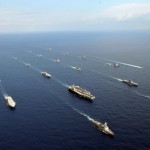 As Chinese drones glide over the Senkaku (Diaoyu) islands, Chinese maritime security vessels thread their way through disputed waters, and two Chinese rigs pump Vietnamese-claimed oil from the waters of the Paracel islands, Beijing’s “salami tactics” seek to change the status quo in East Asia. Each of these moves is beneath the threshold of meriting a forceful response, yet over time they may strengthen Chinese legitimacy and presence in disputed areas, as well as fomenting distrust and discord in America’s alliances.
As Chinese drones glide over the Senkaku (Diaoyu) islands, Chinese maritime security vessels thread their way through disputed waters, and two Chinese rigs pump Vietnamese-claimed oil from the waters of the Paracel islands, Beijing’s “salami tactics” seek to change the status quo in East Asia. Each of these moves is beneath the threshold of meriting a forceful response, yet over time they may strengthen Chinese legitimacy and presence in disputed areas, as well as fomenting distrust and discord in America’s alliances.
How should the United States — which seeks to uphold the regional order — respond?
Increasingly, US allies are questioning the American commitment to Asia. Voices in Japan express doubt that the United States would come to its aid in the Senkaku (Diaoyu) islands. Commentators (see here and here) have blasted the Obama administration for what they see as a weak response to Chinese provocations.
My article, in Foreign Affairs, offers a strategy — drawn from US policy during the Cold War — for dealing with China’s salami tactics today. The Obama administration’s critics are right — that the US must stand up to Beijing on issues related to vital American interests. But on issues peripheral to core US interests, Washington must stand up to its allies too, or risk being drawn into war — potentially a nuclear war. The United States should follow the lead of the Kennedy administration, which stood up not only to the Soviets, but to its West German ally, telling Bonn: you can’t always get what you want.